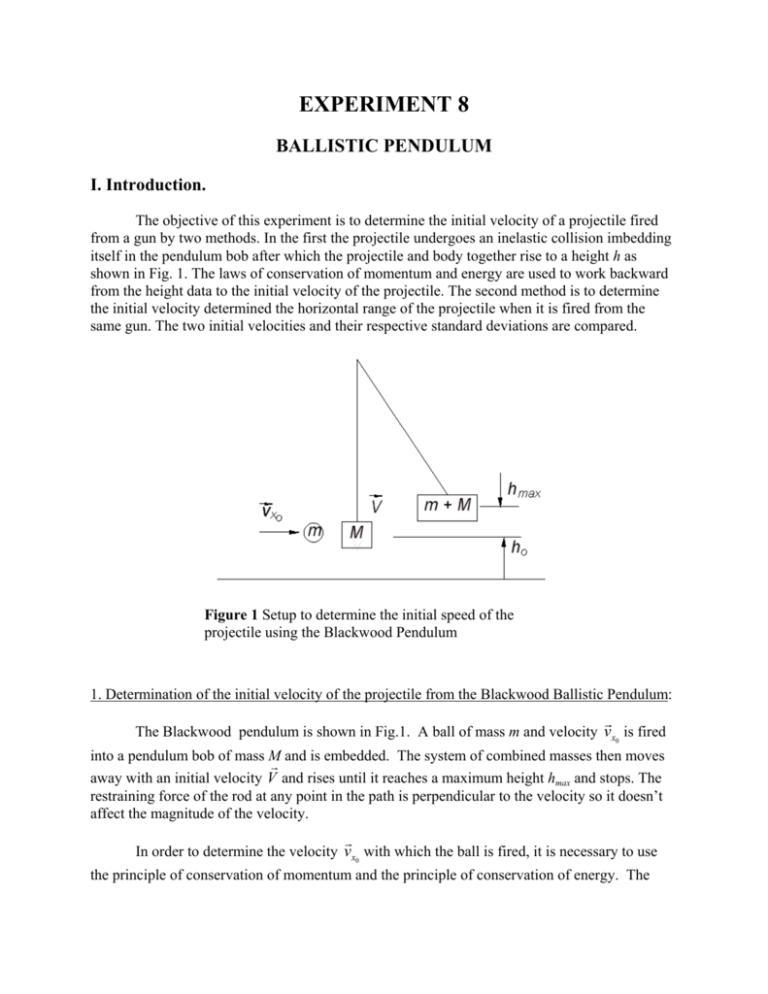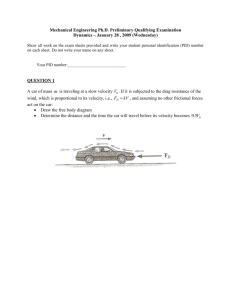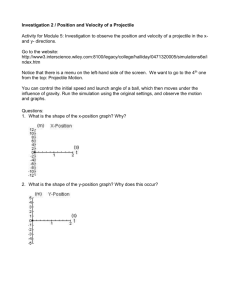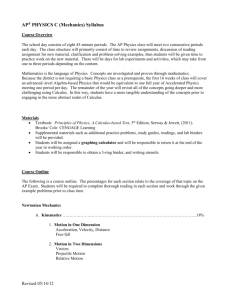Lab for October 28: the ballistic pendulum
advertisement

EXPERIMENT 8 BALLISTIC PENDULUM I. Introduction. The objective of this experiment is to determine the initial velocity of a projectile fired from a gun by two methods. In the first the projectile undergoes an inelastic collision imbedding itself in the pendulum bob after which the projectile and body together rise to a height h as shown in Fig. 1. The laws of conservation of momentum and energy are used to work backward from the height data to the initial velocity of the projectile. The second method is to determine the initial velocity determined the horizontal range of the projectile when it is fired from the same gun. The two initial velocities and their respective standard deviations are compared. Figure 1 Setup to determine the initial speed of the projectile using the Blackwood Pendulum 1. Determination of the initial velocity of the projectile from the Blackwood Ballistic Pendulum: The Blackwood pendulum is shown in Fig.1. A ball of mass m and velocity vx0 is fired into a pendulum bob of mass M and is embedded. The system of combined masses then moves away with an initial velocity V and rises until it reaches a maximum height hmax and stops. The restraining force of the rod at any point in the path is perpendicular to the velocity so it doesn’t affect the magnitude of the velocity. In order to determine the velocity vx0 with which the ball is fired, it is necessary to use the principle of conservation of momentum and the principle of conservation of energy. The momentum of the ball before impact is mvx0 . The instant after the collision the combined masses move away with momentum m M V . The conservation of momentum requires mv0 (m M )V (1) At collision, a significant fraction of the kinetic energy is dissipated into unrecoverable forms because the leaf spring in the bob is deformed, the friction between the ball and the bob, and sound waves. After the projectile is embedded in the bob and assuming no friction in the pendulum mount, the total mechanical energy is a constant. This can be seen from the general expression relating work and energy: K hmax U hmax K h0 U h0 (2) There is no external work done but the combined mass rises until it stops K hmax 0 so the conservation of energy yields 1 2 m M g hmax h0 m M V 2 Eliminating V using Eqs. (1) and (3), vx0 mM m 2 g hmax h0 (3) (4) All of the quantities on the right-hand side of the equation can be readily measured so the magnitude of vx0 is determined from these values. 2. Determination of initial velocity v from the Trajectory When a projectile is fired horizontally from a height y0 and strikes the ground or a table, a determination of the range provides the initial velocity vx0 of the projectile. Fig. 2 shows the setup for the measurement. Figure 2. The trajectory for a projectile fire horizontally The general equations of motion in two dimensions, (x,y), for a mass in free fall and no acceleration along the horizontal component, are: 1 y y0 v y0 t gt 2 2 (5) and x x0 vx0 t (6) where x0 and y0 are the initial displacements. If the projectile is fired horizontally, vy0 = 0. Taking x0 = 0, and eliminating the common parameter t of Eqs. (5), and (6), we can write: gx 2 y y0 2 2vx0 vx0 or g x 2 y0 y If we measure from the point of impact, y = 0 and x = R, so that vx0 g R 2 y0 (7) II Equipment and Procedure Equipment Ballistic Pendulum, paper, carbon paper, rubber mat Procedure 1. Ballistic Pendulum a. Detach the pendulum. Determine the mass of the pendulum and separately that of the projectile (ball). Record these masses. b. The pendulum has a small pawl at its base that moves smoothly over a vertical stem with a curved serrated surface which catches a pawl on the pendulum bob as soon as it tries to return, that is, at its maximum height. Fire the projectile six times and record the position of the pawl on the serrated surface. Record which serration the pawl is on each time. Then determine the average position of the pawl on the serrated surface. c. Set the pendulum so that the pawl is on the “average” serration. There is a center of mass pointed on the housing of the pendulum. Measure the change in height of the center of mass pointer on the pendulum at the “average” serration from its hanging position. Eq. 4 then yields the initial velocity of the projectile. 2. Trajectory Procedure. a. Level the base of the gun and mark the position of the base so that it can be returned to that position if it moves. b. Measure the height of the bottom of the ball above the table. c. Fire the projectile a few times to see its approximate range on the table. Make sure the tension in the spring remains constant by tightening the knob at the end of the gun after each firing. Check the position of the base each time the gun is fired to make sure the position hasn’t changed. Readjust the position of the base if necessary. After the range has been established, tape carbon backed paper in that range so the impact points can be determined. d. Fire the projectile six times and measure the impact position along the table from the un-cocked position of the ball to the middle of the point of impact on the table. Make sure the tension in the spring has remained constant by tightening the knob at the end of the gun after each firing and readjust the position of the base if necessary. Determine the average distance and the standard deviation of the mean of the distance. Use a backstop to avoid hitting other students or the wall. . III Data A. Ballistic Pendulum Table 1. Height of Pawl in terms of Serration Trial B. Pawl Height (Serration) Range Height y0 of the bottom of the ball above the table__________________ Table 2. Range of projectile fired from a height y0 and the differences from the average, R . Trial Ri Ri R R R i 2 IV. RESULTS A. Determine the average velocity of the projectile from for the Ballistic Pendulum procedure, Eq. (4) and the standard deviation from the average velocity v0 mM m v 0 2 gh = ________m/s __________ m/s B. Determine the average velocity of the projectile from the range procedure, Eq. (7) and the standard deviation from the average vx0 R g = 2 y0 __________________________________m/s v = ___________m/s 0 C. Calculate the percent difference between the average velocities determined in A. and B. V. Conclusion and Discussion 1. Is the average initial velocity determined by the two methods consistent (a small percent difference)? If so, examine the standard deviations of the mean for the two procedures. Do they indicate if one method is preferable? If one of the standard deviations is greater than the other what may be the cause? 2. Determine the kinetic energy of the system before impact and after the projectile has lodged in the pendulum. If there is a difference, account for it. 3. Does any friction present in the pendulum support change the height of the swing? 4. The pendulum system rotates after the collision. The kinetic energy of this rotating system has been neglected in the calculation of the kinetic energy. What effect does this have on the determination of the height achieved by the bob? 5. Is the horizontal force on the pendulum is zero during the collision? What evidence do you have that it is or is not?









